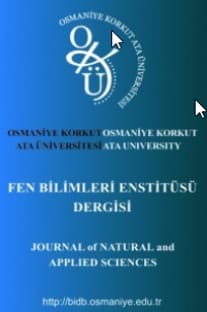Keban Baraj Gölü Seviye Değişiminin ANFİS ve Destek Vektör Makineleri ile Tahmini
Estimation of Keban Dam Lake Level Change Using ANFIS and Support Vector Machines
___
- [1] Ripple W. The capacity of storage for water supply, Proc., Institution of Civil Engineers 1883; 71, 270.
- [2] Sudler CE. Storage required for regulation of streamflow, Trans., ASCE 1927; 91, 622.
- [3] Keskin ME., Terzi O., Taylan D. Fuzzy logic model approaches to daily pan evaporation estimation in Western Turkey, Hydrological Sciences Journal 2004; 49, 1001-1010.
- [4] Kazeminezhad MH., Etemad-Shahidi A., Mousavi SJ. Application of fuzzy inference system in the prediction of wave parameters, Ocean Engineering 2005; 32, 1709-1725.
- [5] Kisi O. Daily pan evaporation modeling using a neuro-fuzzy computing technique, Journal of Hydrology 2006; 329, 636-646.
- [6] Kisi O., Ozturk O. Adaptive neurofuzzy computing technique for evapo-transpiration estimation, Journal of Irrigation and Drainage Engineering 2007; 133, 368-379.
- [7] Üneş F., Karaeminoğulları AB., Taşar B. Forecasting of river sediment amount using machine model, International Journal of Environment, Agriculture and Biotechnology 2020; 5(1): 9-15.
- [8] Özdülkar K., Üneş F., Demirci M., Kaya YZ. Günlük buharlaşma miktarının bulanık mantık yöntemleri kullanılarak bölgesel olarak modellenmesi, Osmaniye Korkut Ata Üniversitesi Fen Bilimleri Enstitüsü Dergisi 2019; 2(1): 23-29.
- [9] Demirci M., Unes F., Kaya YZ., Mamak M., Tasar B., Ispir E. Estimation of groundwater level using artificial neural networks: a case study of Hatay-Turkey, In 10th International Conference Environmental Engineering. 2017
- [10] Üneş F., Demirci M. Generalized regression neural networks for reservoir level modeling, International Journal of Advanced Computational Engineering and Networking 2015; 3, 81-84.
- [11] Demirci M., Unes F., Kaya YZ., Tasar B., Varcin H. Modeling of dam reservoir volume using adaptive neuro fuzzy method, Aerul si Apa. Componente ale Mediului, 2018; 145-152.
- [12] Campolo M., Andreussi P., Soldati A. River flood forecasting wiht a neural network model, Water Resour. Res. 1999; 35(4): 1191-1197.
- [13] Minns AW., Hall MJ. Artificial neural networks as rainfall-runoff models, Hydrologic Science 1996; 41(3): 399-417.
- [14] Tokar AS., Johnson PA. Rainfall-runoff modeling using artificial neural networks, J. Hydrologic Engrg., ASCE 1999; 4(3): 232- 239.
- [15] Üneş F., Demirci M., Taşar B., Kaya Y Z., Varçin H. Estimating dam reservoir level fluctuations using data-driven techniques, Polish Journal of Environmental Studies 2019; 28(5): 3451-3462.
- [16] Taşar B., Üneş F., Demirci M., Kaya YZ. Yapay sinir ağları yöntemi kullanılarak buharlaşma miktarı tahmini, DÜMF Mühendislik Dergisi 2018; 9(1): 543-551.
- [17] Unes F., Kaya YZ., Mamak M. Daily reference evapotranspiration prediction based on climatic conditions applying different data mining techniques and empirical equations, Theoretical and Applied Climatology 2020; 141, 763-773.
- [18] Üneş F., Demirci M., Taşar B., Kaya Y Z., Varçin H. Modeling of dam reservoir volume using generalized regression neural network, support vector machines and M5 decision tree models. Applied Ecology and Environmental Research 2019; 17(3):7043- 7055.
- [19] Devlet Su İşleri Genel Müdürlüğü, http://www.dsi.gov.tr/
- [20] Cortes C., Vapnik V. Support-vector networks, Machine learning 1995; 20(3): 273-297.
- [21] Hsu CW., Chang CC., Lin CJ. A practical guide to support vector classification. 2003.
- [22] Zadeh LA. Fuzzy sets, Information and Control 1965; 8, 338-353.
- [23] Jang JS. ANFIS: Adaptive-network-based fuzzy inference system, IEEE transactions on systems, man, and cybernetics 1993; 23(3):665-685.
- ISSN: 2687-3729
- Yayın Aralığı: Yılda 3 Sayı
- Başlangıç: 2017
- Yayıncı: Osmaniye Korkut Ata Üniversitesi
Interaction Shallow Tunnels and Structures
Keban Baraj Gölü Seviye Değişiminin ANFİS ve Destek Vektör Makineleri ile Tahmini
Hatice ARSLAN, Fatih ÜNEŞ, Mustafa DEMİRCİ, Bestami TAŞAR, Ada YILMAZ
Cucurbita pepo L. Tohumlarının Yağ Asidi Kompozisyonunun Belirlenmesi Üzerine Bir Çalışma
Hatay İlinde Üretilen Bazı Kuru Kaba Yemlerin Besin Madde İçeriklerinin Belirlenmesi
Süleyman ZAHAL, Şerafettin KAYA
Static Analysis of FGM Plate-Strip with a Rectangular Hole Under Bending
Sığ Tüneller ve Yapıların Etkileşimi
M. Atakan AKAR, Oğuz BAŞ, Hasan SERİN, Berkay KARAÇOR, Mustafa ÖZCANLI
Immunomodulatory Effects of Moringa Oleifera Leaf Meal (MOLM) against Newcastle Disease in Broilers
Madeeha AKRAM, Ijaz SALEEM, Muhammad FARHAB, Zubair LUQMAN
